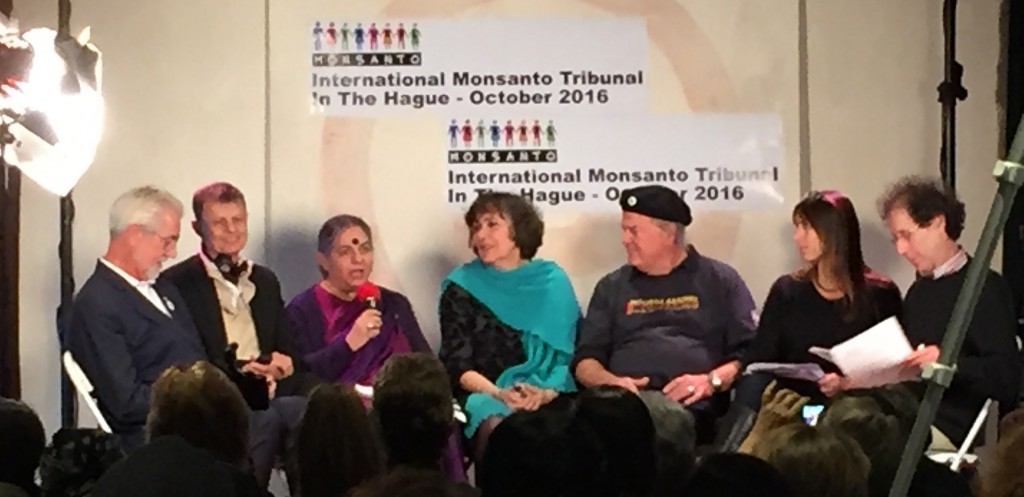Today I woke up with another headache, but this one not as debilitating as yesterday’s. Still it was off to another slow start. Fortunately I did not have to be anywhere immediately, as my first event was at 1 p.m. at Place to B – a press conference about Monsanto with environmental and agricultural activist Vandana Shiva. I am falling into a routine of catching up on news and social media posts in the morning before actually going out to do things in the afternoon. That’s okay until I have to be somewhere early.
Before the event Vandana Shiva held her own press conference, and at 1 p.m. she took part in a press conference with several others on an International Tribunal Against Monsanto for Crimes Against Humanity, an activist event planned at the Hague in October 2016. Both events were packed, and I could barely get a spot. While GMOs are a fact of life in the United States – almost all of our corn and soy are genetically modified — they are effectively banned in France. The audience at Place to B was very receptive to the message of this press conference, and many Europeans seem genuinely concerned about the safety of their food and biodiversity in their farming.
Taking part in the press conference were:
- Marie-Monique Robin, film director and writer, author of the movie and book Le monde selon Monsanto (The World According to Monsanto), sponsor of the tribunal (introduction)
- André Leu (Australia), president of IFOAM – International Foundation for Organic Agriculture – (about the consequences of Monsanto on health and biodiversity)
- Dr. Vandana Shiva (India), general director of the Research Foundation for Science, Technology and Ecology (the consequences of Monsanto on farmers and food sovereignty)
- Dr. Hans Rudolf Herren (United States), president of the Millenium Institute of Washington (the consequences of Monsanto on climate change)
- Ronnie Cummins (United States), international director of Organic Consumers (about the impact on the political and regulatory institutions)
- Dr. Olivier de Schutter (Belgium), former Rapporteur on UN Right to Food, professor of international law at Université catholique de Louvain (legal tools of the Tribunal)
- Valérie Cabanes (France), spokeswoman of End Ecocide on Earth (towards the recognition of ecocide as a felony).
About half the speakers spoke in French, half in English. This was a gathering that you would not likely see in the United States. Although the event they are planning for the Hague will not be an official trial, the speakers said it is more than symbolic, as their goal is to establish ecocide as a crime and show that Monsanto is guilty. Among other things, they argued that Monsanto promotes an industrial model of agriculture responsible for 1/3 of greenhouse gas emissions and the depletion of soil and water resources, and that its highly toxic pesticides have damaged the environment, harmed species, and sickened or killed millions of people. Shiva pointed to the rash of suicides among Indian farmers who went into debt buying seeds and pesticides for GMO cotton. Cummins discussed Monsanto’s influence on regulations in the United States and abroad.
You can watch the entire press conference posted by Place to B (French speakers not translated), read anti-Monsanto stories here, here and here; neutral stories here and here; and a pro-Monsanto story here.
After the Monsanto press conference let out, I headed to Le Bourget for more time in the Climate Generations space. Again it took almost an hour to get there from Place to B, so I didn’t arrive until after 3 p.m. I spent some time hanging out at the Sierra Club booth, then doing a more thorough walk-through of the booths in the C section. I had wanted to get to the A and B sections too, but didn’t make it there, as I had promised to record a presentation on “Plastification of the ocean” starting at 5 p.m.
Unfortunately it turned out that every speaker on the plastics panel spoke in French. Those in the room could wear headphones to get the translation, but there would be no translation for my video, so I did not keep it. However, I did learn some interesting things. Most of the speakers were people who had led or taken part in various ocean voyages to study and document the amount and types of plastics in the ocean. There is now so much that they have a word for it: the plastosphere. Most people now know about the Great Pacific Garbage Patch, which is a whirlpool of plastic pollution twice the size of Texas in the Pacific. However, there are five such whirlpools across the planet, and there is plastic everywhere. One mission was simply to study it in the Mediterranean. Most of it is not large pieces but microplastics broken down into tiny bits.

Anne-Cécile Turner (second from right), director of Race for Water Foundation, speaks on a panel about plastics in the ocean at COP 21.
One thing the speakers emphasized was preventing plastic from getting to the ocean in the first place through laws like plastic bag bans. But they did not seem all that enthusiastic about projects to clean what is there up, such as this invention by a teenager from Holland. That surprised and disappointed me. Perhaps they don’t think the amount of plastic now in the ocean can be cleaned up. Or maybe they think if people believe it can be cleaned up easily, they will keep on discarding it. Either way, I don’t see how we can not try to clean up the amount of plastics we currently have in the ocean. It is causing untold suffering to billions of sea creatures, and it’s not ethical to allow this. Of course we need to pass laws to prevent it from happening in the first place, but in my opinion we also need to figure out how to clean up what we have put there.
The presentation was in the last time slot of the day, and when it let out everyone in Climate Generations made a beeline for the shuttles to head back to Gare du Nord. My next stop was a meeting of the Sierra Club delegation. There besides going through events of the day and getting an update on negotiations from Fred Heutte, we heard from Sena Alouka, director of Youth Volunteers for the Environment, in Togo, and his colleague, Mavis Mensah. Their organization provides education about climate and environment to schoolchildren.

A group from the Sierra Club catches dinner at a pizzeria in Paris. Clockwise from the lower left are Mavis Mensah, Youth Volunteers for the Environment, Togo; Fred Heutte, Federal and International Climate Campaign; Glen Besa, Virginia Chapter; Sena Alouka, Youth Volunteers for the Environment, Togo; Tyla Matteson, Virginia Chapter; Nicole Ghio, International Campaign; Cathy Cowan Becker, Ohio Chapter; and Steven Sondheim,Tennessee chapter. Photo by Katherine Muller.
Afterward several of us walked to a pizzeria that Fred knew, where I got a great dinner and enjoyed even better company. Besides the two guests from Togo, we had Glen Besa and Tyla Matteson of the Virginia chapter, Fred Heutte of the Federal & International Climate Campaign, Nicole Ghio of the International Campaign, Steven Sondheim of the Tennessee chapter, and a new person, Katherine Muller from South Carolina. Steven told me she knew how to work a room, and he was right. She talked to every single person there, got their stories, and told us hers. I ended up there late looking at all the photos on her phone and finding out what she did that day. Turns out she had visited the sites of the terrorist attacks, and the photos were so amazing that I decided I to go myself the next day. By the end of the night I felt as if I had encountered a long lost friend.








